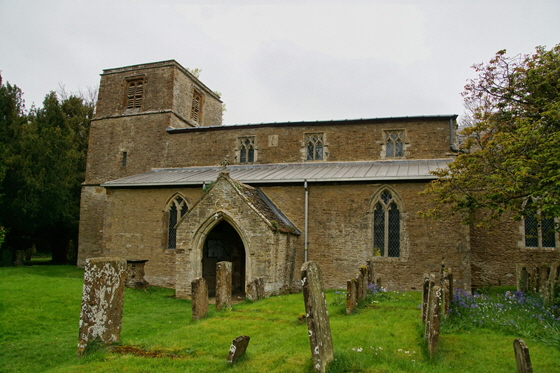|
|
|||||||||||||||||||||||||||||
|
matter. A sequence depicting the Life of the Virgin is a rare survival of the Reformation. The Life of Christ is shown in the north aisle. The OT is represented by the Flight into Egypt. We have a Massacre of the Innocents. What we don’t see is almost as worthy of comment: there is no overbearing figure of St Christoper, that hardy perennial of mediaeval murals. There was some over-painting by the scripture-loving brigade but with much less destructive effect than usual. There was a certain amount of deliberate defacement of religious faces, however. The paintings re-emerged in 1921. |
 |
 |
|
Left: Looking towards the east, Note the different capital son the aisles. The rood screen is fourteenth century. Right: Looking towards the west. The tower arch is Early English. |
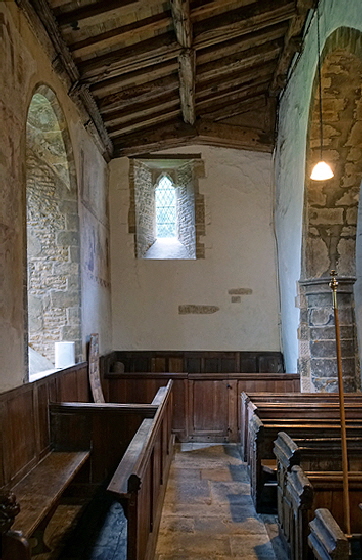 |
|||||||||||||||||||||||||
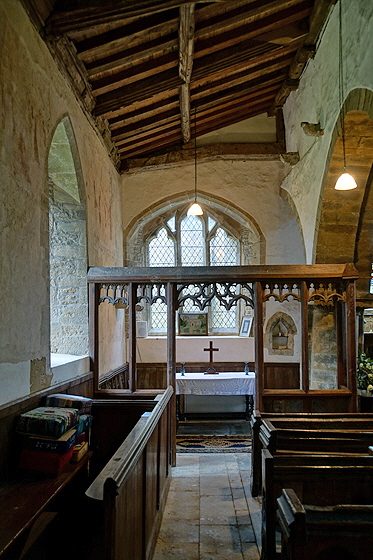 |
 |
||||||||||||||||||||||||
|
Left: Looking to the east end of the north aisle. There is a rather odd half-arch at the western end which the Church Guide thinks was added when it was realised that the north aisle was shorter than the south. It seems rather odd if the masons miscalculated. Note the wall painting faintly visible to the left. Centre: The west end of the south aisle. Wall painting is, again, visible. Right: Looking through the half arch into the east end of the north aisle. |
|||||||||||||||||||||||||
 |
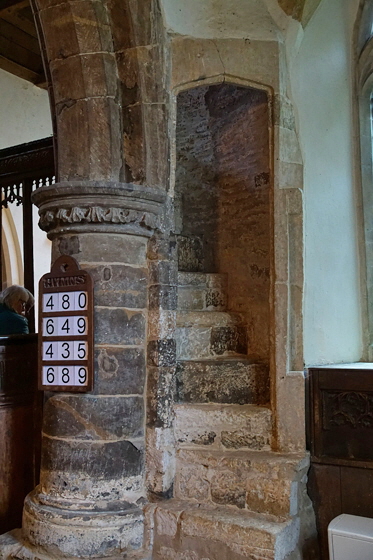 |
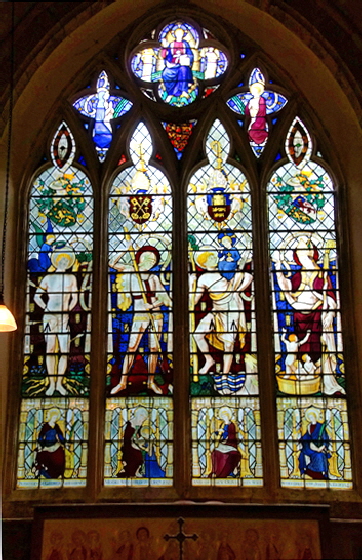 |
|||||||||||||||||||||||
|
Left: The north column of the chancel arch gives way to the a column of the later north aisle. Note the simple scallop pattern of the capital. Centre: The eastern column of the south aisle alongside the rood stair. Note the shell design on the capital and its greater sophistication. Right: The east window. |
|||||||||||||||||||||||||
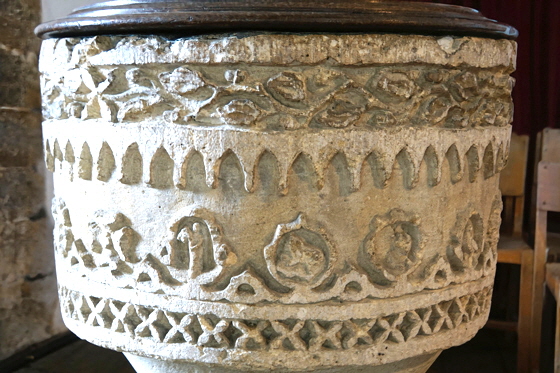 |
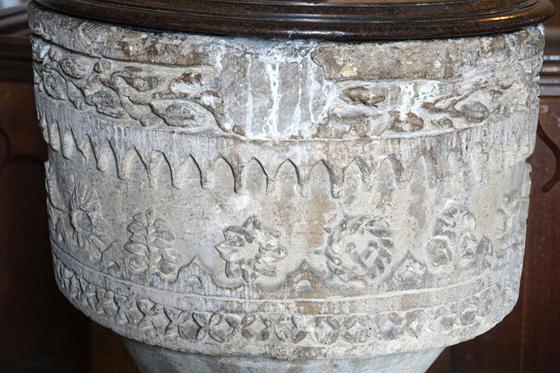 |
||||||||||||||||||||||||
|
Two views of the font. If I was asked to date it, I would unhesitatingly say thirteenth century, citing the dog tooth moulding along the base and the crude rosettes and pointy arch heads. Controversy rules, however. There are suggestions it was a plain Norman tub font that was later recut and others that a Victorian rector had it done between 1819-48. What strikes me is that although the design looks consistent, in fact it is not. Compare these two pictures. The base on the left is of geometric dog tooth mouldings. On the left the shapes are not fully connected to each other and they are slightly countersunk in the fashion of petals or leaves. All of the carving looks shallower and circular leaf patterns are different. On the left they are enclosed, on the right they are not. It is hard to make sense of this but it looks like it has gone through at least two phases of sculpture! |
|||||||||||||||||||||||||
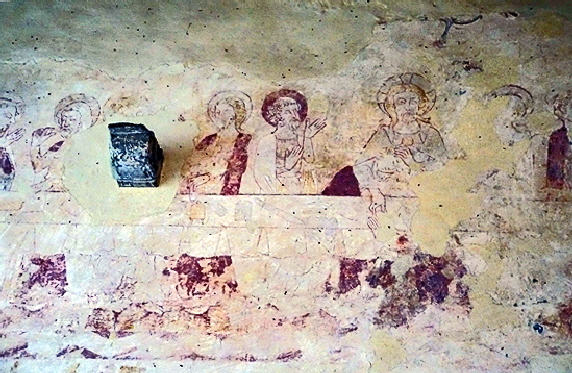 |
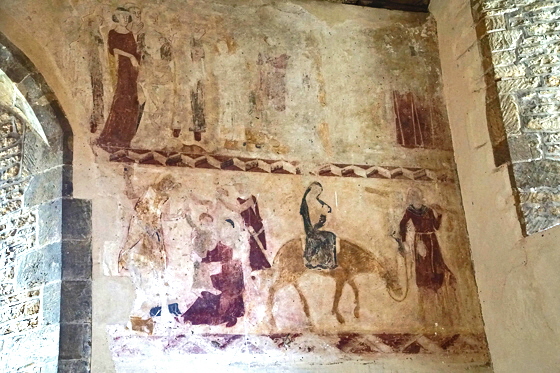 |
||||||||||||||||||||||||
|
Left: A well -preserved fragment of the Last Supper. Leonardo’s version was a bit better. Right: On the south aisle wall are scenes from the life of Mary. On the lower tier left is the Nativity and on the right the Flight into Egypt. Joseph leads the donkey, while Mary cradles Jesus, |
|||||||||||||||||||||||||
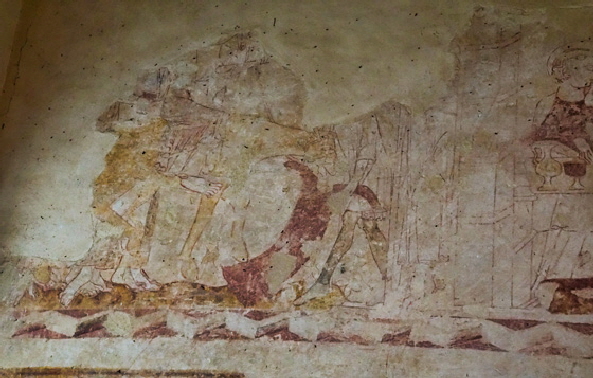 |
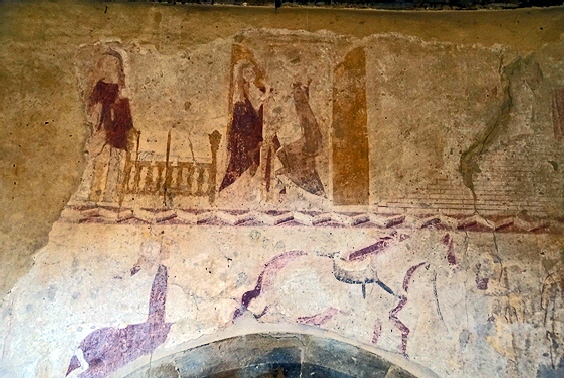 |
||||||||||||||||||||||||
|
Left and Right: Two of the more legible scenes but I am afraid that interpretation of them is beyond my limited scriptural knowledge! In the right hand scene a horse can be seen bestriding the arch. |
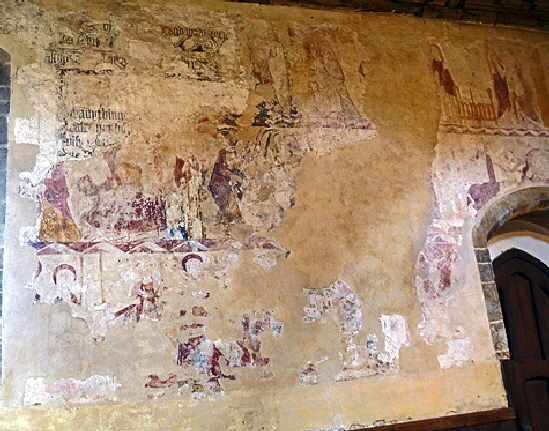 |
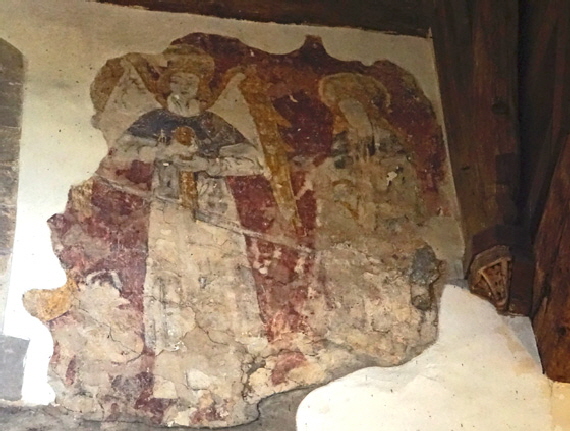 |
|||||||||||||||||||
|
Left: Scenes from the Life of Mary. Right: St Michael on the left is weighing the souls, the scales in his hands. On the right is Mary interceding although we can’t see how. At Slapton (also in Northants, she is clearly seen placing her hand one of the scale pans. On the doom painting in Coventry Holy Trinity, remarkably, she sits at Christ’s feet and offers her breast in supplication. This non-scriptural quality, of course, like many attributes of the Virgin, was contrived by the mediaeval church leaders in their development of the Marian cult. One might feel - I hope I am not being cynical - that this was a sure-fire way of making Christ’s mother a venerable figure to the general population. |
||||||||||||||||||||
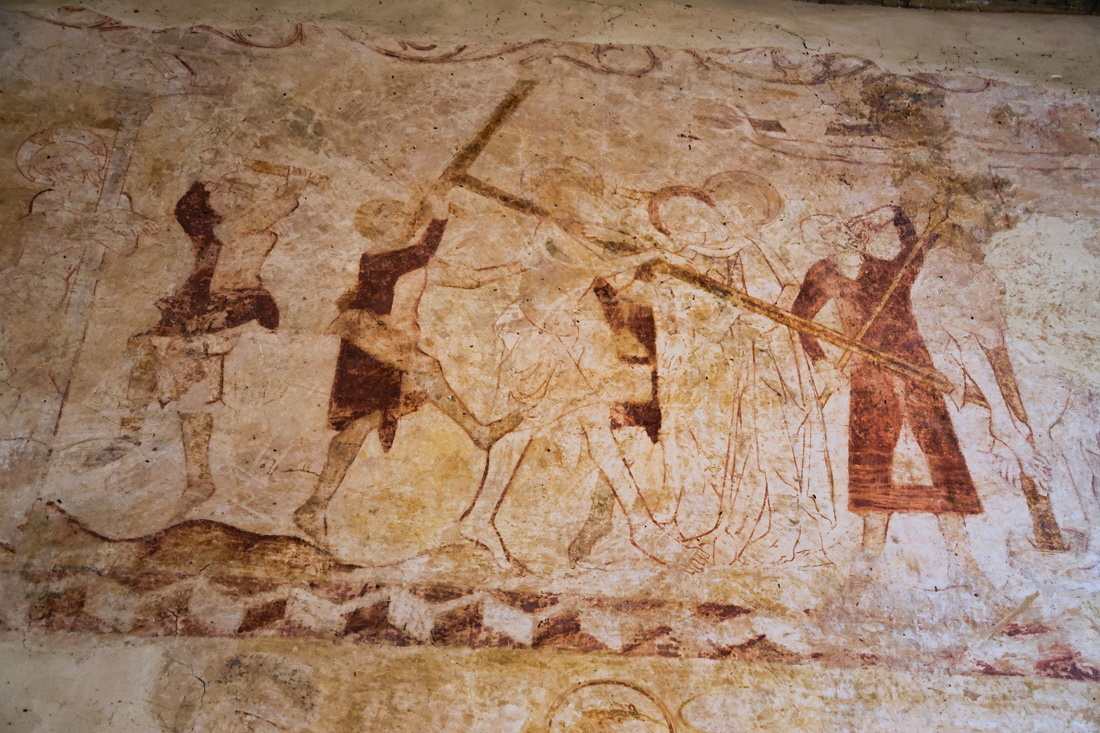 |
||||||||||||||||||||
|
A quite remarkable image. On the left Christ is tied to a post and a man to his right wields a scourge. Then we see Christ carrying his cross. It is “T” shaped rather than the “traditional” shape. Two saintly figures to his right are probably Mary and St John. Behind Christ a man seems to be hanging onto the cross and kicking Christ at the same time. Another figure far right seems to be holding a spear - perhaps another tormentor. |
||||||||||||||||||||
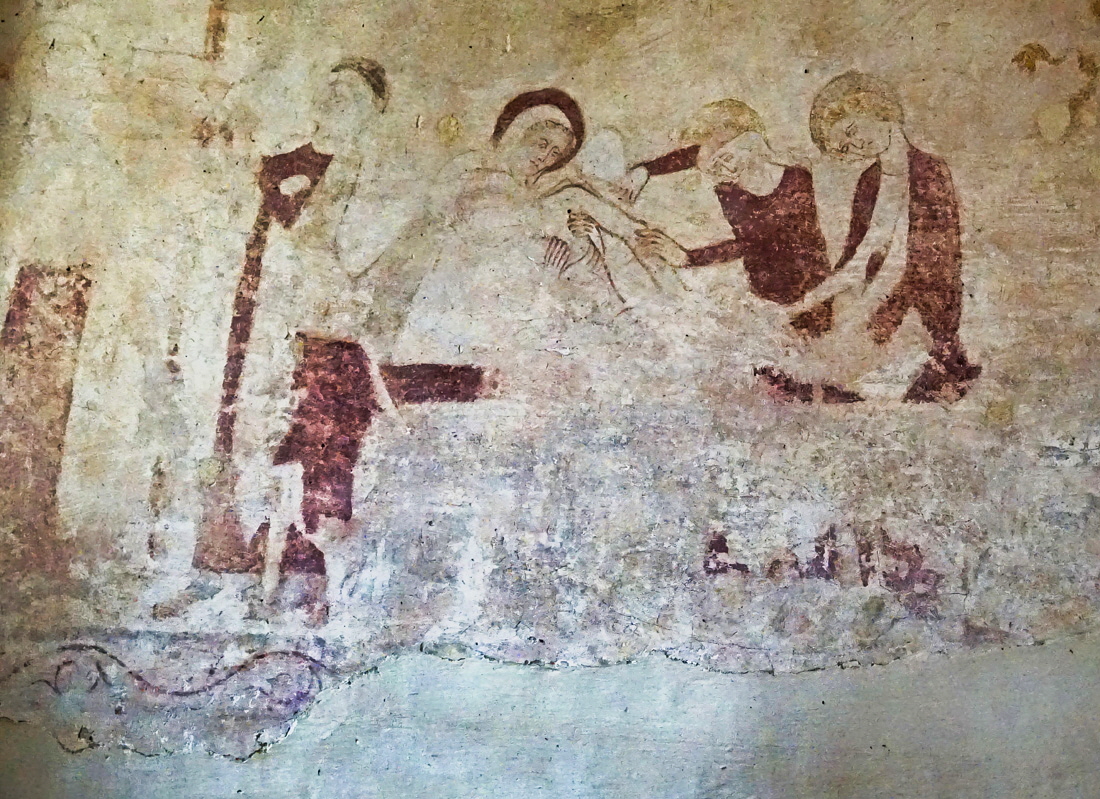 |
||||||||||||||||||||
|
To the left of this picture Christ is being taken down from the cross - the so-called “deposition”. To the right Christ is slumped in the arms of one a figure with very finely-drawn facial features. To the left of that is possibly Joseph of Aramathea, Two other attendants - women? - are to his right. |
||||||||||||||||||||
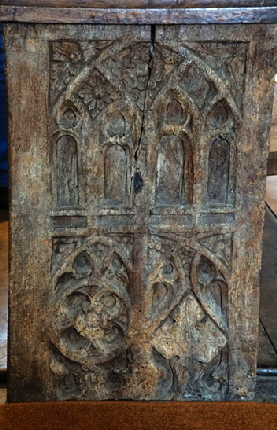 |
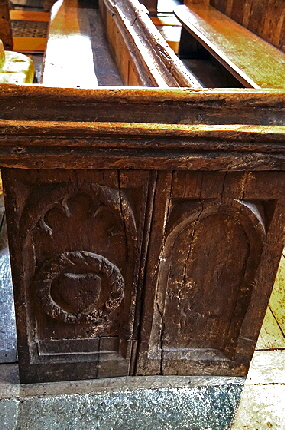 |
 |
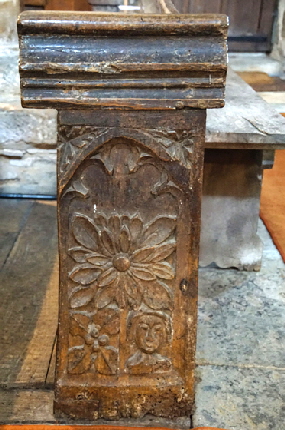 |
|||||||||||||||||
|
There is a variety of decorated bench ends. fairly obviously from different eras. Second Left, I am guessing, is the Eucharist vessel and a wafer. |
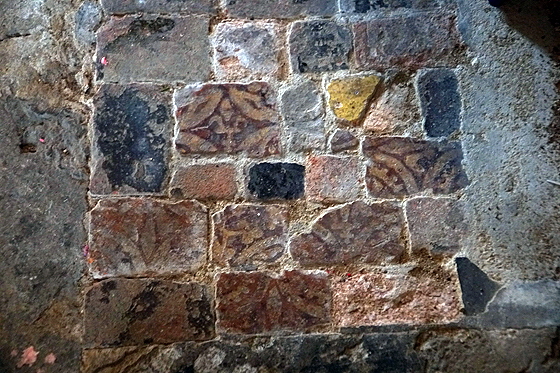 |
|||
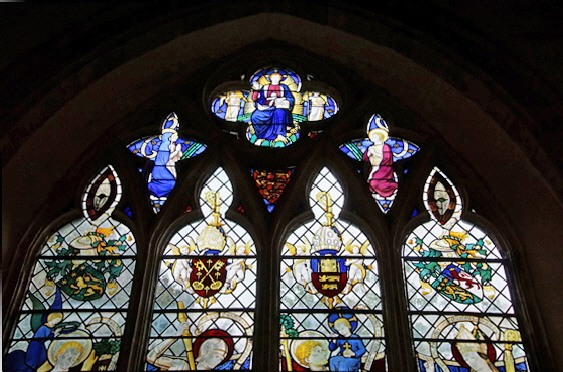 |
|||
|
Left: Fragments of mediaeval tiles. Right: Top lights of the east window. |
|
|
|
|
I hope you have enjoyed this Page and, perhaps, many more besides. Could you help me to make it better still and preserve its future? |
|
You May Download and/or Print These pages from the Link Below |
|
|
|||
